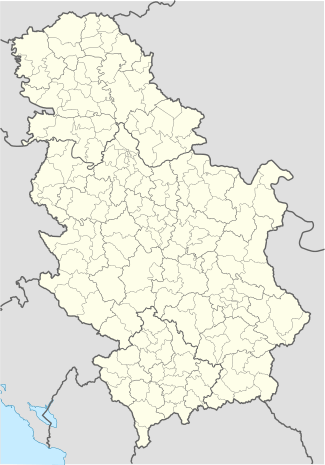Persecution of Croats in Serbia during the Croatian War of Independence

Following the beginning of the Yugoslav wars, members of Serbian Radical Party and Serbian Chetnik Movement have been suspected to have conducted a campaign of intimidation of Croats of Serbia in Vojvodina, Serbia, through hate speech and threats by various parties including the ICTY.[1][2] These acts forced a part of the local Croat population to leave the area in 1992. Most of them were resettled in Croatia. [1][2][3][4] The affected locations included Hrtkovci, Nikinci, Novi Slankamen, Ruma, Šid, and other places bordering Croatia.[1] According to some estimates, around 10,000 Croats left Vojvodina in 1992.[5]
Description
In 1991, Hrtkovci was an ethnically mixed village with Croatian plurality (40.24%), located roughly 40 miles west of Belgrade. Vojislav Šešelj, the leader of the Serbian Radical Party, made numerous public threats to Croats in 1992.[6][7] Radicals replaced all Latin signs with Cyrillic ones and even renamed Hrtkovci to "Srbislavci" - 'place of Serbs' - though only for a short amount of time.[2] Šešelj personally visited Hrtkovci in May 1992 and gave an inflammatory speech by publicly reading out a list of 17 Croat "traitors" who must leave the village.[2][8] Incoming Serb refugees labeled Croats as "fascists".[3]
Following the threats, one part of local Croats rushed to Croatia to see the houses which were offered to them in the planned population transfer.[3] One Croat was even murdered by the radicals.[9] Šešelj's party even crafted a slogan for their campaign: "All Croats out of Hrtkovci".[10] In 1991, Hrtkovci had 2,684 residents, 40.24% were Croats, 20.49% Serbs, 19.19% Hungarians, and 16.58% Yugoslavs.[3] By the end of 1992, 75% of its residents were Serbs.[3]
The number of Croats who left from the village of Hrtkovci was 722.[11] Their empty homes were settled by Serb refugees from Croatia and Bosnia. Likewise, some Serbs tried to protect their Croatian neighbors.[12] After the events, Yugoslav authorities arrested five radicals who were responsible for harassment of Croats. [2]
See also
References
- 1 2 3 "The Prosecutor against Vojislav Seselj - Third Amended Indictment" (PDF). ICTY. December 2007. Retrieved January 19, 2011.
- 1 2 3 4 5 Marcus Tanner (August 1992). "'Cleansing' row prompts crisis in Vojvodina". The Independent. Retrieved January 19, 2011.
- 1 2 3 4 5 Chuck Sudetic (July 26, 1992). "Serbs Force An Exodus From Plain". New York Times. Retrieved January 19, 2011.
- ↑ "Podsećanje na slučaj Hrtkovci". B92. May 4, 2005. Retrieved January 19, 2011.
- ↑ Naegele, Jolyon (February 21, 2003). "Serbia: Witnesses Recall Ethnic Cleansing As Seselj Prepares For Hague Surrender". Radio Free Europe. Retrieved 15 September 2011.
- ↑ "Slučaj Šešelj - Vojislav Šešelj - Izjave" (in Serbian). Helsinki Committee for Human Rights in Serbia. Retrieved 2011-09-02.
- ↑ "Warning that couldn't be ignored". Sense Agency. 2010-02-16. Retrieved 2011-09-02.
- ↑ "Drastic Changes in Ethnic Composition of Population". Sense Agency. 21 October 2008. Retrieved 15 September 2011.
- ↑ Roger Cohen (August 31, 1992). "A Farm Village in Serbia Distills War Into Hatred". New York Times. Retrieved January 19, 2011.
- ↑ Final report of the United Nations Commission of Experts, established pursuant to UN Security Council resolution 780 (1992), Annex III.A — M. Cherif Bassiouni; S/1994/674/Add.2 (Vol. IV), 27 May 1994, Special Forces, (p. 1091). Accessdate January 20, 2011
- ↑ "The charges against Vojislav Seselj". BBC News. 2003-02-24. Retrieved 30 August 2010.
- ↑ "Kandić: Šešelja za Hrtkovce optužuju i Srbi". Vesti online. May 6, 2010. Retrieved January 19, 2011.
